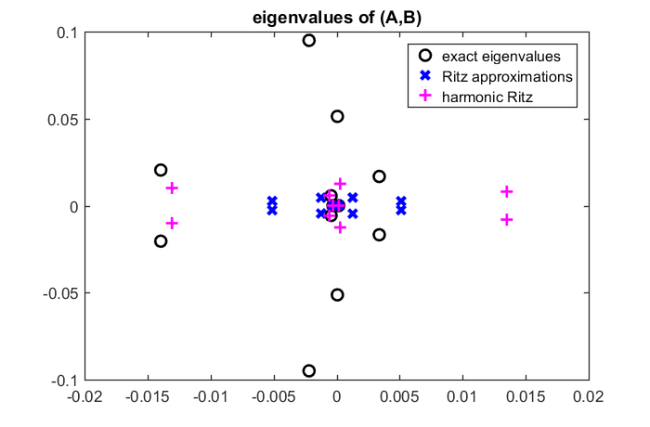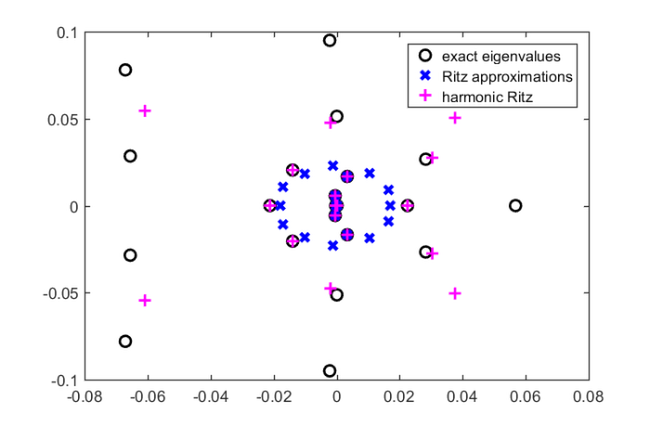Solving large sparse eigenvalue problems
Mario Berljafa and Stefan GüttelDownload PDF or m-file
Contents
Introduction
The first use of rational Krylov methods was for the solution of large sparse eigenvalue problems  , where
, where  and
and  are
are  matrices and
matrices and  are the wanted eigenpairs; see [3, 4, 5, 6]. Let
are the wanted eigenpairs; see [3, 4, 5, 6]. Let  be an
be an  vector and
vector and  a positive integer. The rational Krylov space
a positive integer. The rational Krylov space  is defined as
is defined as  Here,
Here,  is a polynomial of degree at most
is a polynomial of degree at most  having roots
having roots  , called poles of the rational Krylov space. If
, called poles of the rational Krylov space. If  is a constant nonzero polynomial, then
is a constant nonzero polynomial, then  is a standard (polynomial) Krylov space.
is a standard (polynomial) Krylov space.
The rational Arnoldi method [4, 5] can be used to compute an orthonormal basis  of
of  such that a rational Arnoldi decomposition
such that a rational Arnoldi decomposition  is satisfied, where
is satisfied, where  and
and  are upper Hessenberg matrices of size
are upper Hessenberg matrices of size  .
.
In the following we initialize two matrices for the pencil  and plot the full spectrum
and plot the full spectrum  . For simplicity we take
. For simplicity we take  and choose a rather small size to be able to compute all eigenvalues exactly.
and choose a rather small size to be able to compute all eigenvalues exactly.
load west0479 A = west0479; B = speye(479); ee = eig(full(A), full(B)); % Cannot do this for larger matrices! figure, plot(ee, 'ko', 'linewidth', 2), hold on title('eigenvalues of (A,B)') legend('exact eigenvalues')

We now construct a rational Krylov space with  poles all set to zero, i.e., we are interested in the generalized eigenvalues of
poles all set to zero, i.e., we are interested in the generalized eigenvalues of  closest to zero. The inner product for the rational Krylov space can be defined by the user, or otherwise is the standard Euclidean one. (Since
closest to zero. The inner product for the rational Krylov space can be defined by the user, or otherwise is the standard Euclidean one. (Since  in this example, the two coincide.)
in this example, the two coincide.)
rng(0); b = randn(479,1); m = 10; xi = repmat(0, 1, m); param.inner_product = @(x,y) y'*B*x; [V, K, H] = rat_krylov(A, B, b, xi, param); warning off, nrmA = normest(A); nrmB = normest(B); warning on
We can easily check the validity of the rational Arnoldi decomposition by veryfing that the residual norm is close to machine precision:
disp(norm(A*V*K - B*V*H)/(nrmA + nrmB))
2.6796e-18
The basis  is close to orthonormal too:
is close to orthonormal too:
disp(norm(param.inner_product(V, V)-eye(m+1)))
7.5209e-16
Extracting approximate eigenpairs
A common approach for extracting approximate eigenpairs from a search space is by using Ritz approximations or variants thereof. Let  be an
be an  matrix, and
matrix, and  an
an  matrix. The pair
matrix. The pair  is called a
is called a
- Ritz pair for
 with respect to
with respect to  if
if  ;
; - harmonic Ritz pair for
 with respect to
with respect to  if
if  .
.
Assume that  is nonsingular. It follows easily (see [1, Lemma 2.4] and [2, Theorem 2.1]) from
is nonsingular. It follows easily (see [1, Lemma 2.4] and [2, Theorem 2.1]) from  and the definition of (harmonic) Ritz pairs given above that
and the definition of (harmonic) Ritz pairs given above that
- Ritz pairs
 for
for  with respect to
with respect to  arise from solutions of the generalized eigenvalue problem
arise from solutions of the generalized eigenvalue problem  . Since
. Since  is of full rank,
is of full rank,  is nonsingular, and we can equivalently solve the standard eigenvalue problem
is nonsingular, and we can equivalently solve the standard eigenvalue problem  ;
; - harmonic Ritz pairs
 for
for  with respect to
with respect to  arise from solutions of the generalized eigenvalue problem
arise from solutions of the generalized eigenvalue problem  . Since
. Since  is of full rank,
is of full rank,  is nonsingular, and we can equivalently solve the standard eigenvalue problem
is nonsingular, and we can equivalently solve the standard eigenvalue problem  , and take
, and take  .
.
[Xr, Dr] = eig(K\H); [Xh, Dh] = eig(H\K); ritz = diag(Dr); hrm_ritz = 1./diag(Dh); plot(real(ritz), imag(ritz),'bx', 'linewidth', 3) plot(real(hrm_ritz), imag(hrm_ritz),'m+', 'linewidth', 2) axis([-0.02, 0.02, -0.1, 0.1]) legend('exact eigenvalues', ... 'Ritz approximations', ... 'harmonic Ritz')

Accuracy of the approximate eigenpairs
We can evaluate the accuracy of the (harmonic) Ritz pairs from the relative residual norm  . From the rational Arnoldi decomposition
. From the rational Arnoldi decomposition  we have
we have  . Hence, a cheap estimate of the accuracy of an approximate eigenpair is the norm
. Hence, a cheap estimate of the accuracy of an approximate eigenpair is the norm  . If this norm is small compared to
. If this norm is small compared to  , we have computed an eigenpair of a nearby problem. It seems that in this example two eigenpairs have already converged to very high accuracy:
, we have computed an eigenpair of a nearby problem. It seems that in this example two eigenpairs have already converged to very high accuracy:
approx_residue = @(X) arrayfun(@(i)norm(X(:, i)), 1:size(X, 2));
approx_res = [approx_residue(H*Xr-K*Xr*Dr).' ...
approx_residue(H*Xh-K*Xh*diag(hrm_ritz)).'];
disp(approx_res)
5.1976e-08 4.5063e-19 5.1976e-08 6.1961e-17 4.5828e-08 8.2255e-07 4.5828e-08 8.2255e-07 6.6227e-08 1.5529e-07 6.6227e-08 1.5529e-07 6.6756e-08 1.5303e-07 6.6756e-08 1.5303e-07 1.2580e-17 2.3565e-07 1.5728e-15 2.3565e-07
Expanding the rational Arnoldi decomposition
Let us perform  further iterations with rat_krylov, with
further iterations with rat_krylov, with  repeated poles being the harmonic Ritz eigenvalues expected to converge next. Since the poles appear in complex-conjugate pairs, we can turn on the real flag for rat_krylov and end up with a real-valued quasi rational Arnoldi decomposition [6].
repeated poles being the harmonic Ritz eigenvalues expected to converge next. Since the poles appear in complex-conjugate pairs, we can turn on the real flag for rat_krylov and end up with a real-valued quasi rational Arnoldi decomposition [6].
[~, ind] = sort(approx_res(:, 2)); xi = repmat(hrm_ritz(ind([3, 4]))', 1, 4); param.real = 1; [V, K, H] = rat_krylov(A, B, V, K, H, xi, param);
Let us check the residual norm of the extended rational Arnoldi decomposition, and verify that the decomposition has the original  poles at zero, and the newly selected
poles at zero, and the newly selected  poles.
poles.
disp(norm(A*V*K - B*V*H)/(nrmA + nrmB)) disp(util_pencil_poles(K, H).')
2.9720e-18 0.0000e+00 + 0.0000e+00i 0.0000e+00 + 0.0000e+00i 0.0000e+00 + 0.0000e+00i 0.0000e+00 + 0.0000e+00i 0.0000e+00 + 0.0000e+00i 0.0000e+00 + 0.0000e+00i 0.0000e+00 + 0.0000e+00i 0.0000e+00 + 0.0000e+00i 0.0000e+00 + 0.0000e+00i 0.0000e+00 + 0.0000e+00i 2.8261e-04 - 1.2537e-02i 2.8261e-04 + 1.2537e-02i 2.8261e-04 - 1.2537e-02i 2.8261e-04 + 1.2537e-02i 2.8261e-04 - 1.2537e-02i 2.8261e-04 + 1.2537e-02i 2.8261e-04 - 1.2537e-02i 2.8261e-04 + 1.2537e-02i
Finally, the (improved)  Ritz pairs are evaluated, both standard and harmonic.
Ritz pairs are evaluated, both standard and harmonic.
[Xr, Dr] = eig(K\H);
[Xh, Dh] = eig(H\K);
ritz = diag(Dr);
hrm_ritz = 1./diag(Dh);
approx_res = [approx_residue(H*Xr-K*Xr*Dr).' ...
approx_residue(H*Xh-K*Xh*diag(hrm_ritz)).'];
disp(approx_res)
7.8102e-10 8.8386e-20 7.8102e-10 2.5844e-19 1.0521e-09 1.2433e-13 1.5917e-08 1.2433e-13 3.4226e-10 3.3683e-11 3.4226e-10 2.3079e-10 5.3472e-10 3.5878e-13 5.3472e-10 3.5878e-13 1.1481e-09 2.3904e-11 1.1481e-09 2.3904e-11 3.9385e-09 9.2915e-09 3.9385e-09 9.2915e-09 6.0424e-16 4.0670e-09 2.5439e-11 4.0670e-09 2.5439e-11 3.3345e-09 9.7244e-12 3.3345e-09 9.7244e-12 9.9538e-09 4.4158e-16 9.9538e-09
figure, plot(ee, 'ko', 'linewidth', 2), hold on plot(real(ritz), imag(ritz),'bx', 'linewidth', 3) plot(real(hrm_ritz), imag(hrm_ritz),'m+', 'linewidth', 2) axis([-0.08, 0.08, -0.1, 0.1]) legend('exact eigenvalues', ... 'Ritz approximations', ... 'harmonic Ritz')

Harmonic Ritz pairs are typically better than (standard) Ritz pairs for interior eigenvalues, thought this is not yet fully understood. Also, for symmetric matrices the two sets of Ritz values interlace each other, and hence their distance is not large as ultimately both sets converge to the same eigenvalues.
References
[1] G. De Samblanx and A. Bultheel. Using implicitly filtered RKS for generalised eigenvalue problems, J. Comput. Appl. Math., 107(2):195--218, 1999.
[2] R. B. Lehoucq and K. Meerbergen. Using generalized Cayley transformations within an inexact rational Krylov sequence method, SIAM J. Matrix Anal. Appl., 20(1):131--148, 1998.
[3] A. Ruhe. Rational Krylov sequence methods for eigenvalue computation, Linear Algebra Appl., 58:391--405, 1984.
[4] A. Ruhe. Rational Krylov algorithms for nonsymmetric eigenvalue problems, Recent Advances in Iterative Methods. Springer New York, pp. 149--164, 1994.
[5] A. Ruhe. Rational Krylov: A practical algorithm for large sparse nonsymmetric matrix pencils, SIAM J. Sci. Comput., 19(5):1535--1551, 1998.
[6] A. Ruhe. The rational Krylov algorithm for nonsymmetric eigenvalue problems. III: Complex shifts for real matrices, BIT, 34(1):165--176, 1994.